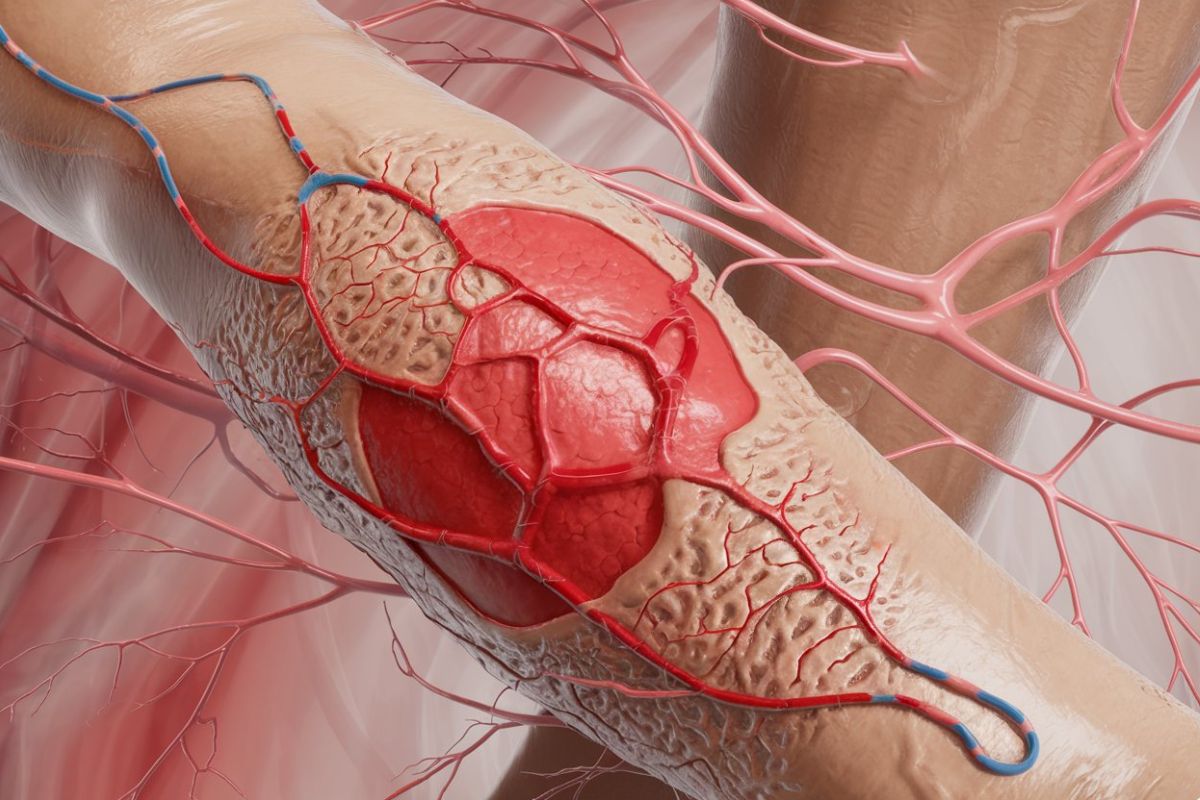
Parkes Weber Syndrome is a rare congenital condition that affects blood vessels and can lead to significant limb abnormalities. Imagine being born with a leg that grows faster than the other, or having a port-wine stain on your skin. These are just a few signs of this complex disorder. It involves arteriovenous malformations (AVMs) and capillary malformations, causing abnormal blood flow. This can result in pain, swelling, and even heart problems. Diagnosing and managing Parkes Weber Syndrome requires a team of specialists and various treatments. Understanding this condition can help improve the quality of life for those affected.
Key Takeaways:
- Parkes Weber Syndrome is a rare condition causing abnormal blood vessel formations, leading to limb overgrowth and heart complications. It requires specialized imaging and multidisciplinary care for management.
- Patients with Parkes Weber Syndrome may experience limb overgrowth, port-wine birthmarks, and abnormal blood flow, requiring support and advocacy. Ongoing research and patient education are crucial for improving diagnosis and management.
What is Parkes Weber Syndrome?
Parkes Weber Syndrome (PWS) is a rare congenital condition involving abnormal blood vessel formations. These anomalies can lead to various complications, primarily affecting the limbs. Let's dive into some key facts about this condition.
-
Definition: Parkes Weber Syndrome is a rare vascular anomaly involving arteriovenous malformations (AVMs) and capillary malformations, leading to abnormal blood flow and limb overgrowth.
-
Prevalence: The exact prevalence is unknown, but it is considered very rare.
-
Symptoms: Common symptoms include port-wine birthmarks, limb overgrowth, bleeding, ulcers, pain, and heart complications due to abnormal blood flow.
Vascular and Limb Abnormalities
The hallmark of Parkes Weber Syndrome lies in its vascular and limb abnormalities. These can significantly impact a person's quality of life.
-
Vascular Malformations: Characterized by arteriovenous fistulas (AVFs) and capillary malformations, leading to abnormal connections between veins and arteries.
-
Limb Overgrowth: One limb, usually a leg, grows larger and longer than the other due to overgrowth of bones and soft tissues.
-
Capillary Malformations: These appear as flat, pink, red, or purple stains on the skin, often called port-wine stains.
-
Arteriovenous Fistulas: Abnormal connections between arteries and veins that can cause life-threatening complications like abnormal bleeding and heart failure.
Genetic Causes and Inheritance
Understanding the genetic basis of Parkes Weber Syndrome can help in diagnosing and managing the condition.
-
Genetic Causes: Some cases result from mutations in the RASA1 gene, which disrupts chemical signaling during development.
-
Inheritance Pattern: When caused by RASA1 mutations, it can be inherited in an autosomal dominant pattern, meaning one altered gene copy can cause the disorder.
-
Somatic Mutations: Recent studies have identified somatic mutations in genes like RASA1 and KRAS as causes of the syndrome.
Diagnostic Challenges and Imaging
Diagnosing Parkes Weber Syndrome can be tricky due to its rarity and the need for specialized imaging studies.
-
Diagnostic Challenges: Diagnosis requires a multidisciplinary approach and often involves imaging studies like MRI and angiography.
-
Imaging Studies: MRI and angiography help visualize vascular malformations and their impact on blood flow and limb structure.
Treatment and Management
While there is no cure for Parkes Weber Syndrome, various treatments can help manage symptoms and improve quality of life.
-
Treatment Options: Medications, physical and occupational therapy, compression garments, corrective shoes, and surgical procedures can help manage symptoms.
-
Surgical Interventions: Procedures like embolization, excision of overgrown tissues, and amputation in severe cases aim to alleviate symptoms and prevent complications.
-
Multidisciplinary Care: Involves specialists like interventional radiologists, dermatologists, general surgeons, hematologists/oncologists, and otolaryngologists.
Complications and Emergency Considerations
Parkes Weber Syndrome can lead to severe complications, making it crucial to recognize and manage the condition promptly.
-
Emergency Department Considerations: Important to recognize due to potential severe complications. Patients may present with symptoms like unilateral leg swelling.
-
Cardiac Complications: Abnormal blood flow can lead to heart complications like heart failure due to cardiac overload.
-
Neurological Complications: Less common but can include life-threatening conditions like subarachnoid hemorrhage if AVMs occur in the brain.
-
Lymphedema: Some cases can be associated with lymphedema, swelling of soft tissues due to impaired lymphatic drainage.
Similar Conditions and Genetic Testing
Parkes Weber Syndrome shares similarities with other vascular anomalies, and genetic testing can aid in diagnosis.
-
Similarities with Other Conditions: Shares similarities with conditions like Klippel-Trenaunay Syndrome, involving vascular malformations present at birth.
-
Genetic Testing: Can help identify mutations in genes like RASA1, crucial for diagnosing the condition and planning management strategies.
-
Family History: While most cases are sporadic, a family history of capillary or arteriovenous malformations can be an important diagnostic clue.
Physical Examination and Patient Support
Physical examination findings and patient support play a vital role in managing Parkes Weber Syndrome.
-
Physical Examination Findings: Include port-wine stains, limb overgrowth, and signs of abnormal blood flow like warmth and swelling of the affected limb.
-
Patient Support and Advocacy: Patients often require significant support and advocacy. Organizations providing resources for rare genetic conditions can be helpful.
Research and Education
Ongoing research and patient education are essential for improving the diagnosis and management of Parkes Weber Syndrome.
-
Clinical Trials: Ongoing trials aim to improve diagnosis and management, often involving interdisciplinary teams and innovative treatments like gene therapy.
-
Catalog of Genes and Diseases: Listed in the Catalog of Genes and Diseases from OMIM, providing detailed information about the genetic basis and clinical features.
-
Genetic and Rare Diseases Information Center: GARD provides comprehensive information about the syndrome, including symptoms, diagnosis, and management options.
-
Scientific Articles: Numerous articles detail the pathophysiology, clinical presentation, and management strategies, highlighting the latest research findings.
-
Patient Education: Educating patients about their condition is crucial for effective management, including understanding symptoms, the importance of follow-up appointments, and the role of various therapies.
-
Multidisciplinary Management: Involves a team of healthcare providers from various fields, working together to manage the condition effectively.
Understanding Parkes Weber Syndrome
Parkes Weber Syndrome is a rare and complex condition involving arteriovenous malformations and capillary malformations. It often leads to limb overgrowth, port-wine birthmarks, and serious complications like heart failure. Diagnosing it can be tricky, requiring a team of specialists and advanced imaging techniques. While there's no cure, treatments like medications, surgical interventions, and physical therapy can help manage symptoms and improve quality of life. Genetic testing can identify mutations in genes like RASA1, aiding in diagnosis and family planning. Patients need ongoing support and education to navigate this challenging condition. Multidisciplinary care is crucial for effective management. By staying informed and working closely with healthcare providers, those affected can better handle the complexities of Parkes Weber Syndrome.
Frequently Asked Questions
Was this page helpful?
Our commitment to delivering trustworthy and engaging content is at the heart of what we do. Each fact on our site is contributed by real users like you, bringing a wealth of diverse insights and information. To ensure the highest standards of accuracy and reliability, our dedicated editors meticulously review each submission. This process guarantees that the facts we share are not only fascinating but also credible. Trust in our commitment to quality and authenticity as you explore and learn with us.


